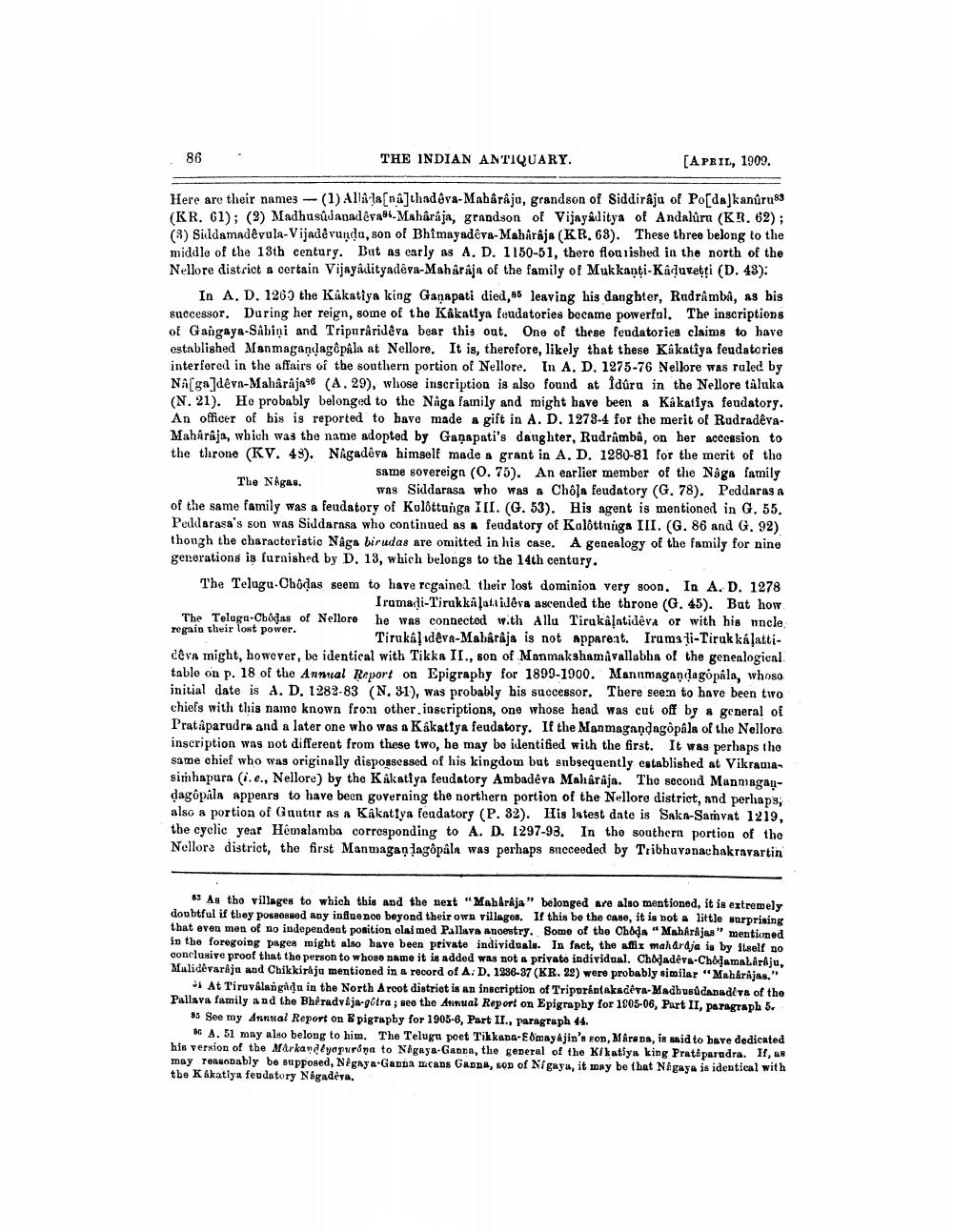________________
86
.
THE INDIAN ANTIQUARY.
[APRIL, 1909.
Here are their names -(1) Alla la[na]thadêva-Mabârâja, grandson of Siddiraja of Po[da]kanûru83 (KR. 61); (3) Madhusûlanadêrasi Maharaja, grandson of Vijayaditya of Andalúru (KR. 62); (3) Siddamadêvula-Vijadê vunda, son of Bhimayadeva-Mahârâja (KR. 63). These three belong to the middle of the 13th century. But as carly as A. D. 1150-51, there flourished in the north of the Nellore district a certain Vijayadityadêva-Maharaja of the family of Mukkanti-Kaduvetti (D. 43):
In A. D. 1269 the Kakatiya king Ganapati died, 95 leaving his dangter, Radrâmba, as bis successor. During her reign, some of the Kakatiya feudatories became powerful. The inscriptions of Gangaya-Sabiņi and Tripurârideva bear this out. One of these feudatories claims to have established Manmagandagepala at Nellore. It is, therefore, likely that these Kakatiya feudatories interfered in the affairs of the southern portion of Nellore. In A. D. 1275-76 Nellore was ruled by NA[ga]dêrn-Maharaja 96 (A. 29), whose inscription is also found at idúru in the Nellore tâluka (N. 21). Ho probably belonged to the Naga family and might have been a Kakatiya feudatory. An officer of his is reported to have made a gift in A. D. 1273-4 for the merit of RudradêvaMaharaja, which was the name adopted by Ganapati's daughter, Rudramba, on her accession to the throne (KV. 45). Nagadêva himself made a grant in A. D. 1280-81 for the merit of the
same sovereign (0.75). An earlier member of the Naga family The Nagas.
was Siddarasa who was a Chola feudatory (G. 78). Peddaras a of the same family was a feudatory of Kulottunga III. (G. 53). His agent is mentioned in G. 55. Peddarasa's son was Siddarasa who continued as a feudatory of Kalottniga III. (G. 86 and G. 92) though the characteristic Naga birudas are omitted in his case. A genealogy of the family for nine generations is furnished by D. 13, which belongs to the 14th century. The Telugu Chodas seem to have regained their lost dominion very soon. In A. D. 1278
Irumadli Tirukkalatiidêva ascended the throne (G. 45). But how The Telaga-Chodas of Nellore he was connected with Allu Tirukálntideva or with his uncle regain their lost power.
Tirukaludēva-Mahârâja is not apparent. Iruma ti-Tiruk kálatticeva might, however, be identical with Tikka II., son of Nonmakshamavallabha of the genealogien tablo on p. 18 of the Annual Report on Epigraphy for 1899-1900. Manamagandagópála, whoso initial date is A. D. 1282-83 (N. 81), was probably his successor. There seen to have been two chiefs with this namo known from other inscriptions, one whose head was cut off by a general of Prataparudra and a later one who was a Kakatiya feudatory. If the Manmagandagopala of the Nellore inscription was not different from these two, he may be identified with the first. It was perhaps the same chief who was originally dispossessed of his kingdom but subsequently established at Vikramas simhapura (i e., Nellore) by the Kakatiya feudatory Ambadeva Maharaja. The second Manmagandagõpila appears to have been governing the northern portion of the Nellore district, and perhaps, also a portion of Guntar as a Kakatiya feudatory (P. 32). His latest date is Saka-Samvat 1219, the cyclic year Hémalamba corresponding to A. D. 1297-93. In the southern portion of the Nellora district, the first Manmaganlagôpâln was perhaps succeeded by Tribhuvanachakravartin
# As tho villages to which this and the next "Mabárája" belonged are also mentioned, it is extremely doubtful if they possossed any influence beyond their own villages. If this be the case, it is not a little surprising that oven men of no independent position olaimed Pallava ancestry. Some of the Choda "Mahkrajas" mentioned in the foregoing pages might also bave been private individuale. In fact, the effi mahardja is by itself no conclusive proof that the person to whose name it is added was not a privato individual. Chodadera-Chamaliraju, Malidevarája and Chikkirkja mentioned in a record of A.D. 1236-37 (KR. 22) were probably similar "Maharajas."
At Tiruvalangadu in the North A root district is an inscription of Tripuriniakadēva-Madhusudanad va of the Pallava family and the Bhiradvlja-gotra; see the Annual Report on Epigraphy for 1005-06, Part II, paragraph 5.
See my Annual Report on pigraphy for 1905-6, Part II., paragraph 14.
A. 51 may also belong to him. The Teluga poet Tikkana-E D'mayajin's ron, Marana, is said to have dedicated his version of the Markayelyapuraya to Nagaya-Ganna, the general of the Kikatiya king Pratiparadra. If, 48 may renovably be supposed, Nigaya Ganna means Gaona, son of Nigayu, it may be that Nagaya is identical with tbe Kakatiya feudatory Nagadéra.




